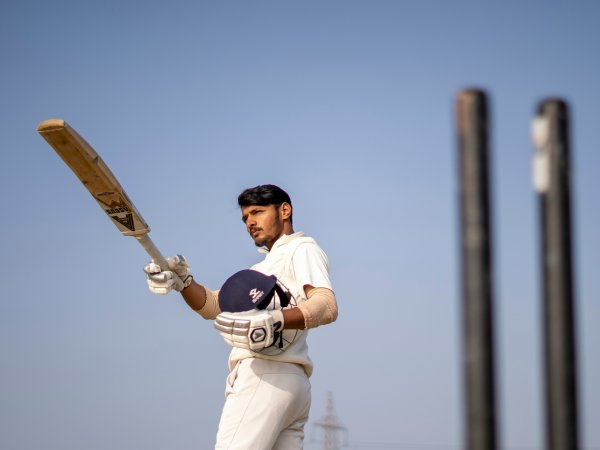Just under 18 percent of the world's population live in India. It is not only its 1.429 billion inhabitants that make the country a highly interesting and exciting sports market. In no other large nation is the population so young - on average ten years younger than in China. Over a quarter of the population is between 15 and 29 years old. Young Indians in particular are so keen on exercise and the outdoors that experts are certain: Sport will be the next big industry in India. Gaurav Vazirani, national director of the New York media agency GroupM, therefore sees excellent opportunities for the future: "The Indian sports industry is ready for further growth and development. The focus is on expansion beyond cricket. Building a strong sports culture can support the development of more world-class athletes and teams."
The Indian sports sector, which includes media rights, sponsorship, clothing, equipment and sports nutrition, is set to reach a total volume of over 100 billion US dollars by 2027 - almost four times as much as the 27 billion dollars from 2020, according to experts from Anand Rathi Investment Banking. The pent-up demand is still enormous. A few figures are enough to understand this: Typically, sport contributes between two and four percent of the workforce in developed countries - with athletes, coaches, event managers, PR experts, equipment manufacturers and many other jobs. In India, on the other hand, the figure is only 0.05 percent. A huge race to catch up is just beginning here.
A major factor here is the support of the government in New Delhi and the Indian states. "Politicians are very determined to promote sport and fitness. A large number of initiatives and programs have been launched," says Gautam Mehra, ISPO Category Manager for India. This is also due to the fact that despite the above-average young population, lifestyle diseases such as obesity, stroke, type 2 diabetes, heart disease and arteriosclerosis have become more and more prevalent in India in recent years. This motivates millions of people to exercise. As a result, the number of gyms and fitness centers is growing by leaps and bounds - which in turn is boosting sales of sports and fitness products.
Politicians in India have understood that an efficient infrastructure is the backbone of the sports ecosystem. That is why the country is currently building numerous new stadiums, training centers, academies and other sports facilities. These include the Gwalior International Cricket Stadium in Madhya Pradesh and the new Gopichand Badminton Academy in Hyderabad. The Narendra Modi Stadium cricket arena in Ahmedabad, the largest sports stadium in the world with 132,000 seats, is already in operation. The final of the Cricket World Cup was held here in November 2023 - where the defeat to Australia in the final was a huge blow for cricket-mad India.
India Sporting Goods Fair 2024
India Sporting Goods Fair 2024 (ISGF) is a sports fair organized by "The Sports Goods Export Promotion Council", an initiative of the Ministry of Commerce and Industry, Government of India. The organization aims to promote India's sports industry and initiate global partnerships.
The ISGF will take place on March 19 and 20, 2024 at The Leela Ambience Convention Hotel in New Delhi.
The passion of Indians for cricket cannot even be compared with the enthusiasm of US fans for American football or the enthusiasm in Europe and South America for soccer. Cricket is more than a sport in India - it is part of the country's culture and connects millions of people. In 2021, cricket accounted for 88% of national spending on sport. However, other sports are slowly catching up: in 2022, cricket's dominance shrank at least a little to 85%.
"Football, for example, is becoming increasingly popular among the young population," says ISPO manager Gautam Mehra. But the figures from the cricket industry are still phenomenal. Player legend Virat Kohli has 266 million followers on Instagram. The Indian Premier League (IPL) received 6.4 billion US dollars from TV broadcasters Viacom18 and Star Sports for its media rights from 2023 to 2027. Only the US football league NFL can compete with such sums. And another fascinating figure: the 2023 IPL final, which the Chennai Super Kings won against the Gujarat Titans, was the most-streamed sports broadcast to date with 32 million viewers worldwide.
But the days when the Indian sports public focused solely on cricket or field hockey are over. There are new heroes and idols. Javelin thrower Neeraj Chopra became India's first athletics Olympic champion in Tokyo in 2021 - and only the second Indian athlete to win an individual medal at the Olympics after shooter Abhinav Bindra (2008). He was showered with medals and multi-million dollar awards in his home country. Among other things, Prime Minister Narendra Modi gave him the equivalent of 113,000 euros in personal prize money. In addition to gold bars, the new national hero also received several cars. But Neeraj Chopra can now travel even more comfortably: He received a lifetime free upgrade to business class from the airline Air India.
In addition to Chopra, who also became world javelin champion in 2023, India has other sports stars who don't have a cricket bat in their hands - including badminton player P. V. Sindhu, weightlifter Saikhom Mirabai Chanu and tennis ace Sania Mirza, former world number one in doubles. They all encourage young Indians to emulate them. Sports expert Gautam Mehra knows that the young generation's self-confidence is growing: "The feeling in India used to be that we didn't stand a chance in top international sport anyway. Now that has changed. And young people are thinking: if they can do it, I can do it too."
Compared to the West and China, the Indian sports market is characterized by many country-specific characteristics. Brands and companies that want to be successful here need to understand them and integrate them into their strategy.
- Cricket dominance: India's national sport enjoys a dominant position - which is reflected in high spectator numbers, extensive sponsorship deals and a considerable amount of merchandising. Cricket absorbs a large proportion of the budgets in Indian sport - but certainly leaves market opportunities for other sports such as soccer, tennis, basketball, boxing and the very popular Indian rugby equivalent, kabaddi.
- Young population: The Indian market is strongly characterized by its "young quarter" between the ages of 15 and 29, which shows a high level of interest in sport and fitness.
- Highly diverse income groups: The market caters to a wide range of income groups, from traditional and highly price-conscious consumers to premium buyers seeking high-end sports goods and experiences. ISPO Manager Gautam Mehra explains: "India used to be a very price-sensitive market. Now there are larger population groups who are able and willing to spend money on premium products." According to Mehra, the size of the population alone creates a lot of potential: "Even if the percentage of people who spend a lot of money here is still relatively low compared to other countries - with 1.4 billion people, this is of course still a huge market."
- Urban vs. rural consumers: While there is a greater awareness and demand for diversity in sports in urban areas, there is a strong inclination towards traditional sports such as cricket and more conservative outdoor activities in rural areas.
- Regional preferences: Apart from cricket, there are regional preferences for certain sports, such as soccer in West Bengal and Kerala or kabaddi in Punjab and Haryana. This diversity leads to a fragmented market with very different target groups.
- Infrastructure: Compared to the established sports markets in China, North America and Europe, India faces major infrastructural challenges that can hinder the growth and professionalization of certain sports.
Sportswear and equipment, especially for cricket, but also for other emerging sports such as soccer and badminton, are good business in India. Home fitness equipment, fitness trackers, protein supplements and sports nutrition are also becoming increasingly popular, especially in the cities. The dominance of cricket is diverting attention and resources away from other sports - but also offers an opportunity to capitalize on the popularity and success of the national sport. Digital services and eSports also have great potential among the tech-savvy young population.
However, the predominance of cricket as well as regionally very different cultures and preferences make it difficult to get started and achieve sustained success - as does the often not overly cooperative administration with its corruption. Tip from ISPO Manager Gautam Mehra: "The Indian sports market is exciting and offers great opportunities for growth. However, if you want to be successful as a foreign player, you should look for local partners who understand the country and its culture."
Cricket legend Harbhajan Singh, world champion in 2011 and now a politician, sums up India's prospects for sporting success as follows: "To make India a sporting nation, a joint effort is needed from everyone. We need to promote a culture of sports and encourage participation in all sports. By investing in sports infrastructure and supporting athletes, we can create a nation of champions."

 Sports BusinessSki Mountaineering Goes Olympic: What Milano-Cortina 2026 Means
Sports BusinessSki Mountaineering Goes Olympic: What Milano-Cortina 2026 Means
- ISPO awards
- Mountain sports
- Bike
- Design
- Retail
- Fitness
- Health
- ISPO Job Market
- ISPO Munich
- ISPO Shanghai
- Running
- Brands
- Sustainability
- Olympia
- OutDoor
- Promotion
- Sports Business
- ISPO Textrends
- Triathlon
- Water sports
- Winter sports
- eSports
- SportsTech
- OutDoor by ISPO
- Heroes
- Transformation
- Sport Fashion
- Urban Culture
- Challenges of a CEO
- Trade fairs
- Sports
- Find the Balance
- Product reviews
- Newsletter Exclusive Area
- Magazine





